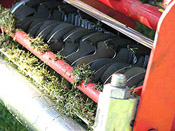Stay The Course
For visits throughout the upper Mid-Continent Region, it is not a matter of if rounds in 2008 are down, but rather a question of by how many . The combination of a winter that ranks among the worst on record and an extended cool, wet spring that slowed green-up and produced tumultuous weather (i.e. flooding, tornados, hail, etc.) has indeed been detrimental to courses financially. The 2008 golfing season has been constrained and courses, particularly public facilities, are suffering from limited play.
Just as golfers tend to unnecessarily press after leaving a few strokes on the front nine, a "catch up" mindset naturally takes hold when feeling behind. In the case of agronomics on the golf course, this has been observed as many consider making-up for lost rounds by not disrupting heavy play in September. Three of the most common strategies being considered and the concerns for these strategies are as follows:
- Delaying necessary cultivation practices until late October or November.
- Intensive aeration and topdressing are best performed when turfgrasses are growing most vigorously so they can easily withstand the stress and recover quickly. For cool-season turfgrasses in the upper Mid-Continent Region, this is usually mid-August through September. Delaying aeration until late October or November does not allow the open holes time to completely recover prior to the onset of winter and, therefore, they will still be present for at least part of the spring golfing season. Open holes during winter on creeping bentgrass greens also increase the risk of winter dessication injury because turfgrass crowns are exposed.
- Aerating too late in the growing season aids the germination and establishment of Poa annua and annual winter weeds within the open holes left by aeration, as creeping bentgrass growth has diminished.
- Performing the cultural practices earlier in the season allows for more daylight hours and a full staff, which are advantageous when performing time-consuming cultural practices.
- Substituting less effective cultivation practices.
- There are no substitutes for cultivation practices that physically remove organic matter, such as core aeration or deep verticutting (i.e. dethatching). Solid tine aeration and injection using water or sand, while beneficial, do not remove organic matter.
- Foregoing fall cultivation practices altogether.
- Omitting topdressing or cultivation practices (even for one autumn season) when creeping bentgrass is growing most rapidly will almost certainly result in the overdevelopment of thatch. So while either can be nixed this fall, failing to keep pace with thatch dilution through sand topdressing and core aeration will consequently require more aggressive cultivation in the future to correct the problem. In the case of thatch control, an ounce of prevention is worth a pound of cure.
- Even if organic matter levels have been effectively managed, aeration is still necessary in late summer/early fall to provide soil compaction relief following heavy play throughout the summer.
While not disrupting September play will certainly boost revenue for 2008, the short-term rewards likely won't be worth risking course conditions in 2009. Stay the course and, chances are, you'll be glad you did.
 |
 |
 |
| (L to R) Core aeration, vertical mowing unit and sand topdressing. | ||
If you would like more information about a Turf Advisory Service visit, do not hesitate to contact either of the Mid-Continent regional offices: Ty McClellan at tmcclellan@usga.org or (630) 340-5853 or Bud White at budwhite@usga.org or (972) 662-1138.
![]()
